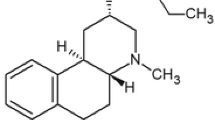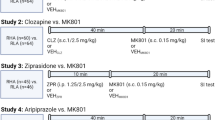Abstract
Rationale
The acetylcholinesterase inhibitors donepezil, galantamine, and rivastigmine are used for the treatment of Alzheimer’s disease. We previously demonstrated that donepezil and galantamine differentially affect isolation rearing-induced prepulse inhibition (PPI) deficits and that this might be due to differential effects on brain muscarinic acetylcholine (mACh) receptor function in mice.
Objectives
We examined the effects of rivastigmine on isolation rearing-induced PPI deficits, brain ACh levels, and mACh receptor function in mice.
Methods
Acoustic startle responses were measured in a startle chamber. Microdialysis was performed, and the levels of dopamine and ACh in the prefrontal cortex were measured.
Results
Rivastigmine (0.3 mg/kg) improved PPI deficits, and this improvement was antagonized by the mACh receptor antagonist telenzepine but not by the nicotinic ACh receptor antagonist mecamylamine. Rivastigmine increased extracellular ACh levels by approximately 2–3-fold, less than the increase produced by galantamine. Rivastigmine enhanced the effect of the mACh receptor agonist N-desmethylclozapine on prefrontal dopamine release, a marker of mACh receptor function, and this increase was blocked by telenzepine. In contrast, galantamine did not affect N-desmethylclozapine-induced dopamine release. Furthermore, rivastigmine did not affect cortical dopamine release induced by the serotonin1A receptor agonist osemozotan, suggesting that the effect of rivastigmine has specificity for mACh receptors.
Conclusions
Taken together with our previous finding that marked increases in ACh levels are required for the PPI deficit improvement induced by galantamine, our present results suggest that rivastigmine improves isolation rearing-induced PPI deficits by increasing ACh levels and by concomitantly enhancing mACh receptor function.





Similar content being viewed by others
References
Ago Y, Sakaue M, Baba A, Matsuda T (2002) Selective reduction by isolation rearing of 5-HT1A receptor-mediated dopamine release in vivo in the frontal cortex of mice. J Neurochem 83:353–359. doi:10.1046/j.1471-4159.2002.01128.x
Ago Y, Koyama Y, Baba A, Matsuda T (2003) Regulation by 5-HT1A receptors of the in vivo release of 5-HT and DA in mouse frontal cortex. Neuropharmacology 45:1050–1056. doi:10.1016/S0028-3908(03)00304-6
Ago Y, Nakamura S, Uda M, Kajii Y, Abe M, Baba A, Matsuda T (2006a) Attenuation by the 5-HT1A receptor agonist osemozotan of the behavioral effects of single and repeated methamphetamine in mice. Neuropharmacology 51:914–922. doi:10.1016/j.neuropharm.2006.06.001
Ago Y, Sato M, Nakamura S, Baba A, Matsuda T (2006b) Lack of enhanced effect of antipsychotics combined with fluvoxamine on acetylcholine release in rat prefrontal cortex. J Pharmacol Sci 102:419–422. doi:10.1254/jphs.SC0060187
Ago Y, Koda K, Ota Y, Kita Y, Fukada A, Takuma K, Matsuda T (2011) Donepezil, but not galantamine, blocks muscarinic receptor-mediated in vitro and in vivo responses. Synapse 65:1373–1377. doi:10.1002/syn.20969
Ago Y, Araki R, Yano K, Kawasaki T, Chaki S, Nakazato A, Onoe H, Hashimoto H, Baba A, Takuma K, Matsuda T (2012) The selective metabotropic glutamate 2/3 receptor agonist MGS0028 reverses isolation rearing-induced abnormal behaviors in mice. J Pharmacol Sci 118:295–298. doi:10.1254/jphs.11200SC
Ago Y, Araki R, Tanaka T, Sasaga A, Nishiyama S, Takuma K, Matsuda T (2013) Role of social encounter-induced activation of prefrontal serotonergic systems in the abnormal behaviors of isolation-reared mice. Neuropsychopharmacology 38:1535–1547. doi:10.1038/npp.2013.52
Araki R, Ago Y, Hasebe S, Nishiyama S, Tanaka T, Oka S, Takuma K, Matsuda T (2014) Involvement of prefrontal AMPA receptors in encounter stimulation-induced hyperactivity in isolation-reared mice. Int J Neuropsychopharmacol 17:883–893. doi:10.1017/S1461145713001582
Atack JR, Perry EK, Bonham JR, Candy JM, Perry RH (1986) Molecular forms of acetylcholinesterase and butyrylcholinesterase in the aged human central nervous system. J Neurochem 47:263–277. doi:10.1111/j.1471-4159.1986.tb02858.x
Ballard CG (2002) Advances in the treatment of Alzheimer’s disease: benefits of dual cholinesterase inhibition. Eur Neurol 47:64–70. doi:10.1159/000047952
Ballmaier M, Casamenti F, Scali C, Mazzoncini R, Zoli M, Pepeu G, Spano PF (2002) Rivastigmine antagonizes deficits in prepulse inhibition induced by selective immunolesioning of cholinergic neurons in nucleus basalis magnocellularis. Neuroscience 114:91–98. doi:10.1016/S0306-4522(02)00234-8
Bitsios P, Giakoumaki SG, Theou K, Frangou S (2006) Increased prepulse inhibition of the acoustic startle response is associated with better strategy formation and execution times in healthy males. Neuropsychologia 44:2494–2499. doi:10.1016/j.neuropsychologia.2006.04.001
Bortolozzi A, Masana M, Díaz-Mataix L, Cortés R, Scorza MC, Gingrich JA, Toth M, Artigas F (2010) Dopamine release induced by atypical antipsychotics in prefrontal cortex requires 5-HT1A receptors but not 5-HT2A receptors. Int J Neuropsychopharmacol 13:1299–1314. doi:10.1017/S146114571000009X
Braff DL, Swerdlow NR, Geyer MA (1999) Symptom correlates of prepulse inhibition deficits in male schizophrenic patients. Am J Psychiatry 156:596–602
Chudasama Y, Robbins TW (2006) Functions of frontostriatal systems in cognition: comparative neuropsychopharmacological studies in rats, monkeys and humans. Biol Psychol 73:19–38. doi:10.1016/j.biopsycho.2006.01.005
Dalley JW, Cardinal RN, Robbins TW (2004) Prefrontal executive and cognitive functions in rodents: neural and neurochemical substrates. Neurosci Biobehav Rev 28:771–784. doi:10.1016/j.neubiorev.2004.09.006
Eskander MF, Nagykery NG, Leung EY, Khelghati B, Geula C (2005) Rivastigmine is a potent inhibitor of acetyl- and butyrylcholinesterase in Alzheimer’s plaques and tangles. Brain Res 1060:144–152. doi:10.1016/j.brainres.2005.08.039
Franklin KBJ, Paxinos G (1997) The mouse brain in stereotaxic coordinates. Academic Press, Inc., San Diego
Furukawa-Hibi Y, Alkam T, Nitta A, Matsuyama A, Mizoguchi H, Suzuki K, Moussaoui S, Yu QS, Greig NH, Nagai T, Yamada K (2011) Butyrylcholinesterase inhibitors ameliorate cognitive dysfunction induced by amyloid-β peptide in mice. Behav Brain Res 225:222–229. doi:10.1016/j.bbr.2011.07.035
Geyer MA, Krebs-Thomson K, Braff DL, Swerdlow NE (2001) Pharmacological studies of prepulse inhibition models of sensorimotor gating deficits in schizophrenia: a decade in review. Psychopharmacology 156:117–154. doi:10.1007/s002130100811
Giacobini E (2003) Cholinesterases: new roles in brain function and in Alzheimer’s disease. Neurochem Res 28:515–522. doi:10.1023/A:1022869222652
Graham FK (1975) The more or less startling effects of weak prestimulation. Psychophysiology 12:238–248. doi:10.1111/j.1469-8986.1975.tb01284.x
Higashino K, Ago Y, Umehara M, Kita Y, Fujita K, Takuma K, Matsuda T (2014) Effects of acute and chronic administration of venlafaxine and desipramine on extracellular monoamine levels in the mouse prefrontal cortex and striatum. Eur J Pharmacol 729:86–93. doi:10.1016/j.ejphar.2014.02.012
Hiramatsu N, Ago Y, Hasebe S, Nishimura A, Mori K, Takuma K, Matsuda T (2013) Synergistic effect of 5-HT1A and σ1 receptor activation on prefrontal dopaminergic transmission under circulating steroid deficiency. Neuropharmacology 75:53–61. doi:10.1016/j.neuropharm.2013.06.026
Islam MR, Moriguchi S, Tagashira H, Fukunaga K (2014) Rivastigmine improves hippocampal neurogenesis and depression-like behaviors via 5-HT1A receptor stimulation in olfactory bulbectomized mice. Neuroscience 272:116–130. doi:10.1016/j.neuroscience.2014.04.046
Koda K, Ago Y, Kawasaki T, Hashimoto H, Baba A, Matsuda T (2008) Galantamine and donepezil differently affect isolation rearing-induced deficits of prepulse inhibition in mice. Psychopharmacology (Berl) 196:293–301. doi:10.1007/s00213-007-0962-1
Koda K, Ago Y, Yano K, Nishimura M, Kobayashi H, Fukada A, Takuma K, Matsuda T (2011) Involvement of decreased muscarinic receptor function in prepulse inhibition deficits in mice reared in social isolation. Br J Pharmacol 162:763–772. doi:10.1111/j.1476-5381.2010.01080.x
Lane RM, Potkin SG, Enz A (2006) Targeting acetylcholinesterase and butyrylcholinesterase in dementia. Int J Neuropsychopharmacol 9:101–124. doi:10.1017/S1461145705005833
Li Z, Huang M, Ichikawa J, Dai J, Meltzer HY (2005) N-desmethylclozapine, a major metabolite of clozapine, increases cortical acetylcholine and dopamine release in vivo via stimulation of M1 muscarinic receptors. Neuropsychopharmacology 30:1986–1995. doi:10.1038/sj.npp.1300768
Li Z, Prus AJ, Dai J, Meltzer HY (2009) Differential effects of M1 and 5-hydroxytryptamine1A receptors on atypical antipsychotic drug-induced dopamine efflux in the medial prefrontal cortex. J Pharmacol Exp Ther 330:948–955. doi:10.1124/jpet.109.155663
Perry EK, Perry RH, Blessed G, Tomlinson BE (1978) Changes in brain cholinesterase in senile dementia of Alzheimer’s type. Neuropathol Appl Neurobiol 4:273–277. doi:10.1111/j.1365-2990.1978.tb00545.x
Sakaue M, Somboonthum P, Nishihara B, Koyama Y, Hashimoto H, Baba A, Matsuda T (2000) Postsynaptic 5-hydroxytryptamine1A receptor activation increases in vivo dopamine release in rat prefrontal cortex. Br J Pharmacol 129:1028–1034
Sato M, Ago Y, Koda K, Nakamura S, Kawasaki T, Baba A, Matsuda T (2007) Role of postsynaptic serotonin1A receptors in risperidone-induced increase in acetylcholine release in rat prefrontal cortex. Eur J Pharmacol 559:155–160. doi:10.1016/j.ejphar.2006.12.007
Swerdlow NR, Light GA, Cadenhead KS, Sprock J, Hsieh MH, Braff DL (2006) Startle gating deficits in a large cohort of patients with schizophrenia: relationship to medications, symptoms, neurocognition, and level of function. Arch Gen Psychiatry 63:1325–1335. doi:10.1001/archpsyc.63.12.1325
Yano K, Koda K, Ago Y, Kobayashi H, Kawasaki T, Takuma K, Matsuda T (2009) Galantamine improves apomorphine-induced deficits in prepulse inhibition via muscarinic ACh receptors in mice. Br J Pharmacol 156:173–180. doi:10.1111/j.1476-5381.2008.00037.x
Acknowledgments
This study was supported in part by KAKENHI (25460099 (YA), 26293020 (HH), 26670122 (HH), 15H01288 (HH), and 15K18874 (YO)); the Neuropsychiatry Drug Discovery Consortium established by Dainippon Sumitomo Pharma Co., Ltd. (Japan) with Osaka University (TM and HH); Takeda Science Foundation (Japan) (YA); Research Foundation for Pharmaceutical Sciences (Japan) (YA); the Program for Advancing Strategic International Networks to Accelerate the Circulation of Talented Researchers (HH); and a fund by Novartis Pharma K.K. (Japan) (110601 (TM)).
Author information
Authors and Affiliations
Corresponding author
Additional information
Kosuke Higashino and Yukio Ago contributed equally to this work.
Rights and permissions
About this article
Cite this article
Higashino, K., Ago, Y., Umeki, T. et al. Rivastigmine improves isolation rearing-induced prepulse inhibition deficits via muscarinic acetylcholine receptors in mice. Psychopharmacology 233, 521–528 (2016). https://doi.org/10.1007/s00213-015-4123-7
Received:
Accepted:
Published:
Issue Date:
DOI: https://doi.org/10.1007/s00213-015-4123-7




